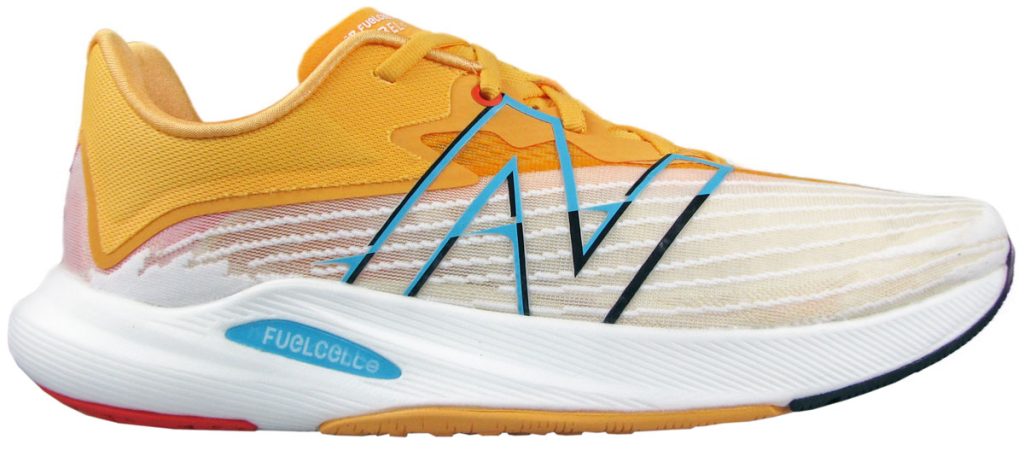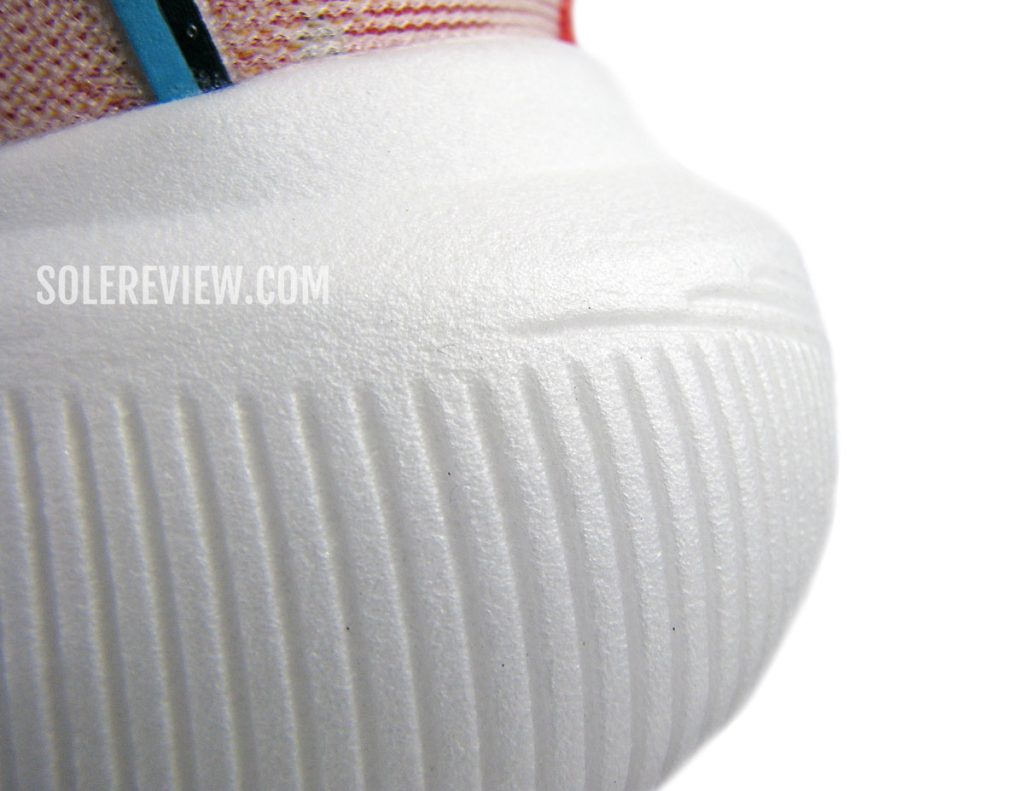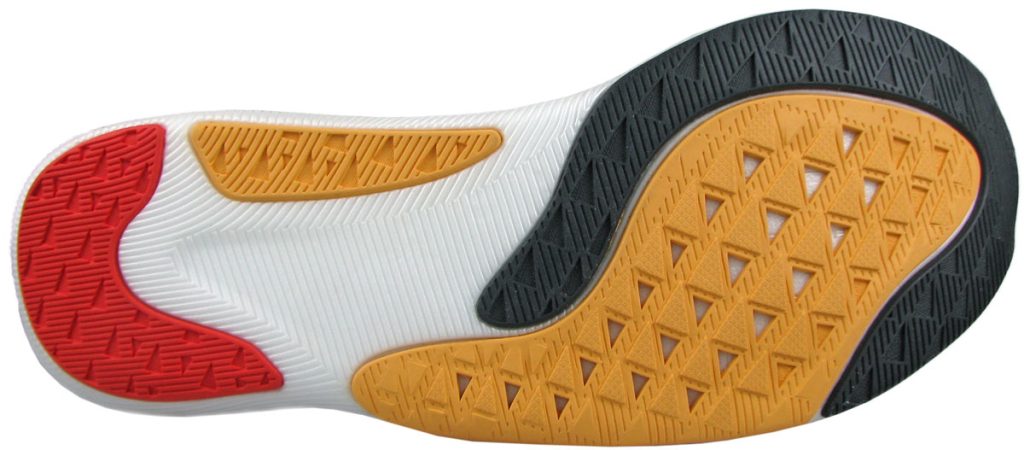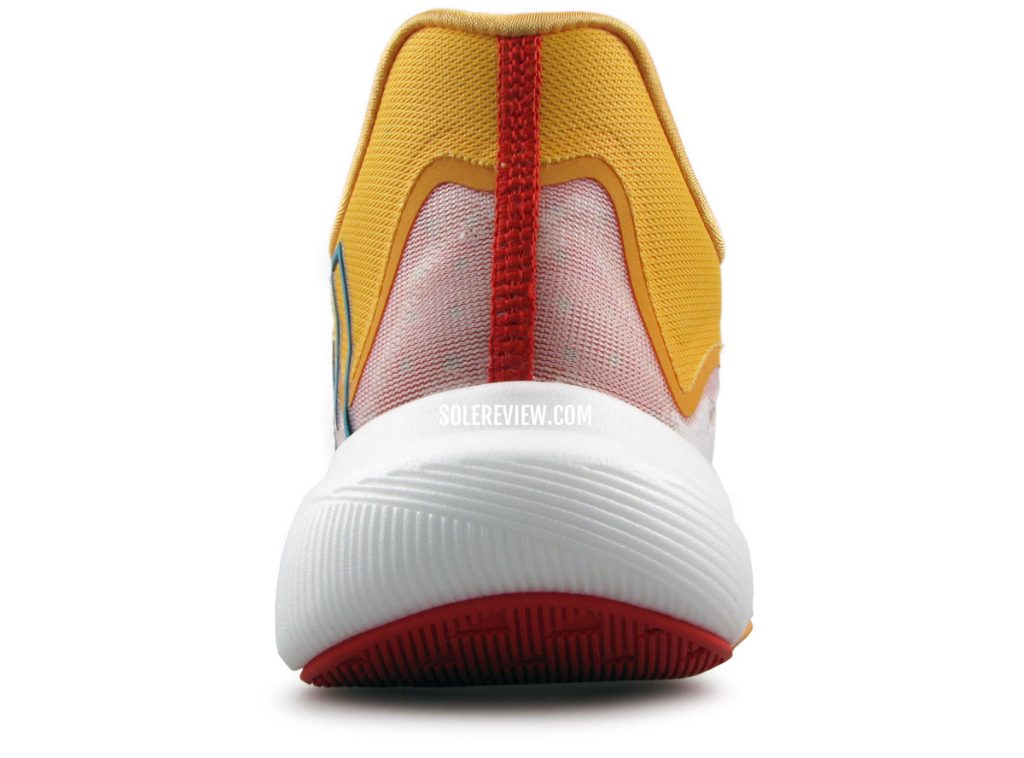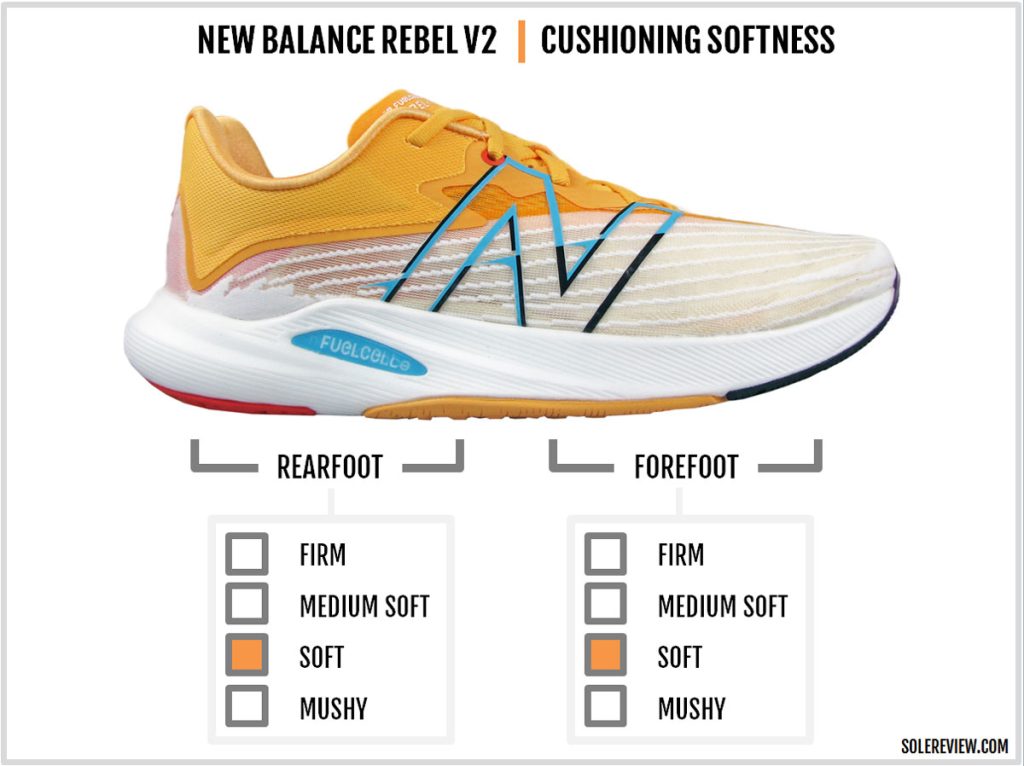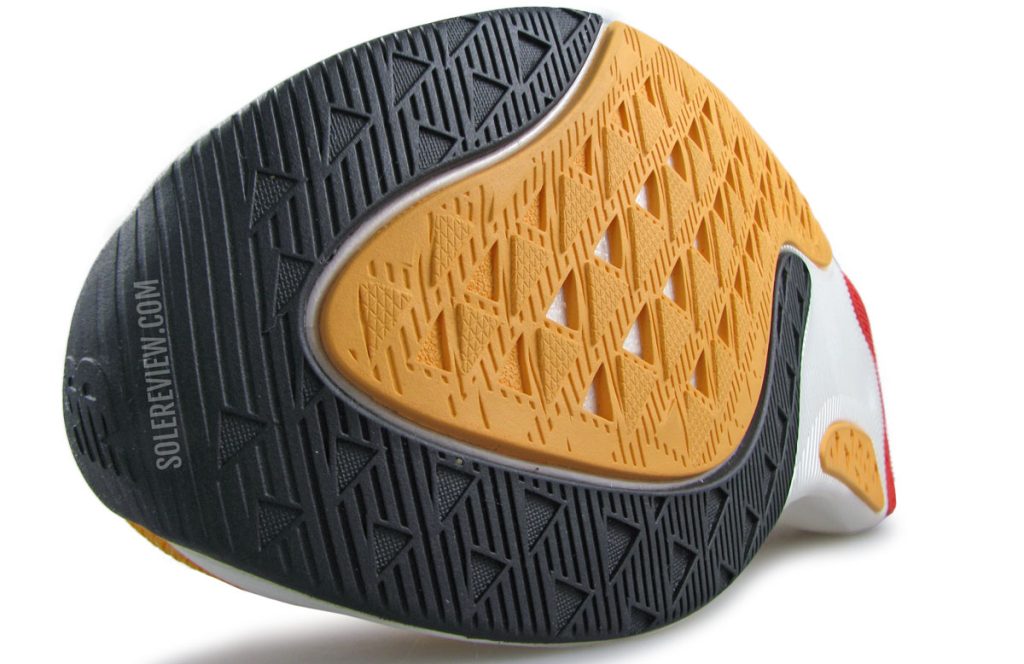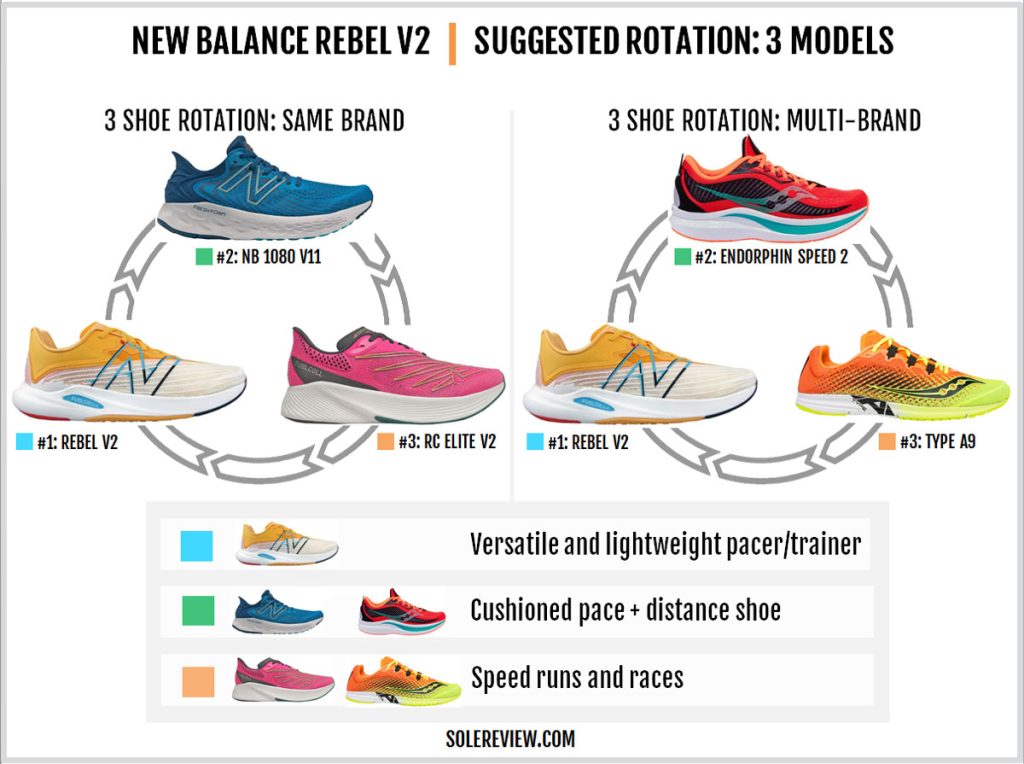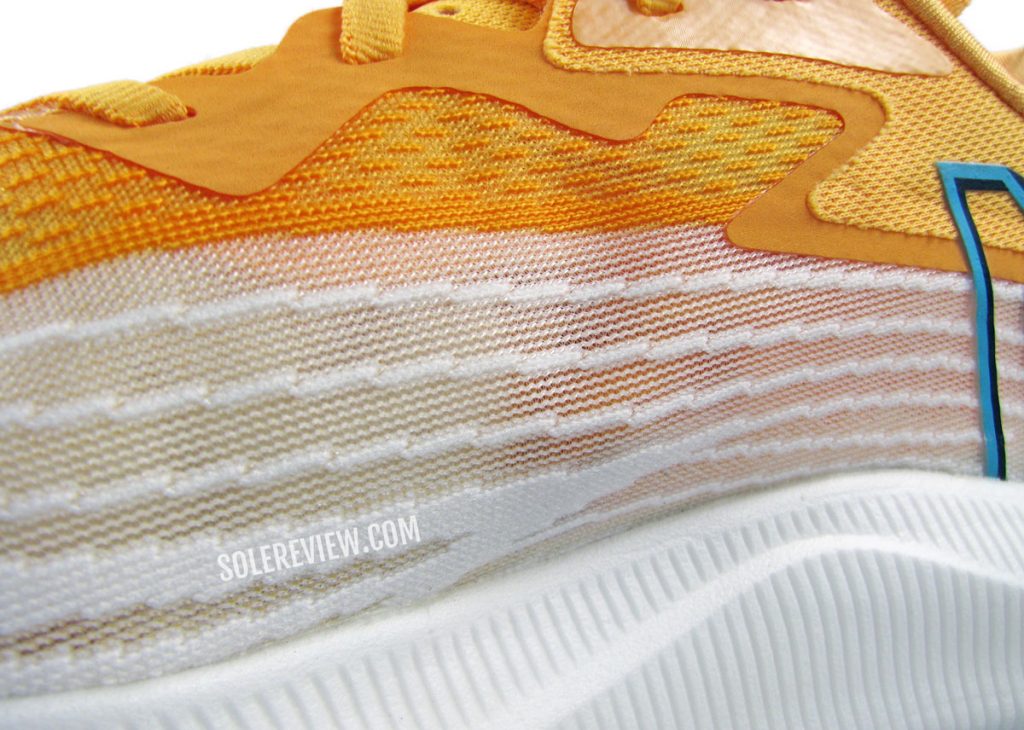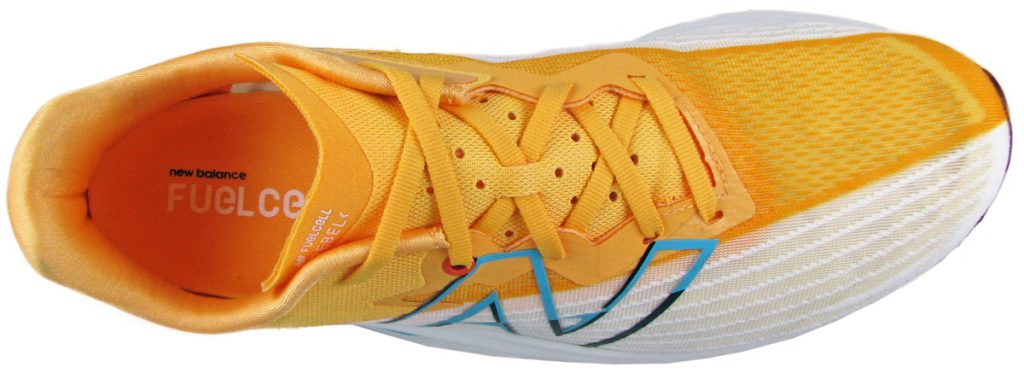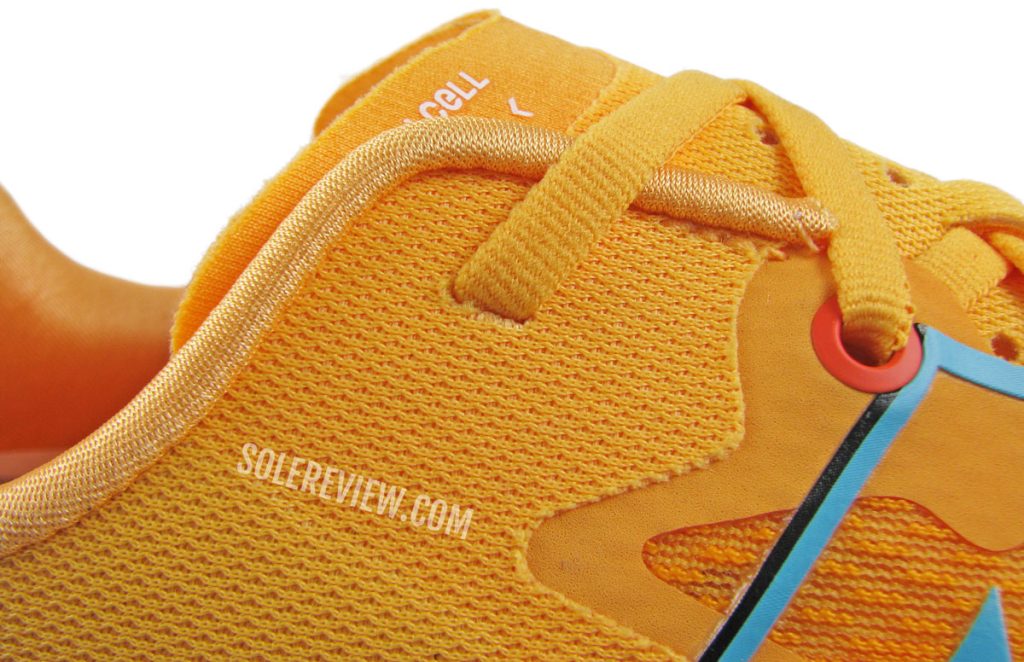The New Balance Fuelcell Rebel V2 was purchased at full retail price for our review.
INTRODUCTION
As the saying goes, hindsight is 20/20.
Looking back, it was apparent that New Balance tried to do too much with the Fuelcell Rebel V1.
The ultra-wide forefoot with the midsole ‘flange’ had a small transition plate, and the bootie upper was cluttered with details and trims.
Even the outsole coverage was mostly limited to the forefoot, and only a tiny slab of rubber covered the heel.
There was no mistaking the Rebel V1’s intentions; it was a forefoot striker’s shoe. While it was a capable tempo-trainer by any yardstick, its unusual design was the divider of opinions.
With the Rebel V2, New Balance pulled a proverbial rabbit out of its hat.
While the Rebel V1’s Fuelcell midsole wasn’t bad, the V2 elevates its game by using the same Fuelcell foam as the RC Elite and Fuelcell TC.
The Rebel 2 is almost like a watered-down FuelCell TC, just without the plate and extra stack height.
From a performance standpoint, the Rebel V2’s ride acquires a transformed character – one that’s softer and bouncier than the V1. And just like the Rebel V1, the V2 maintains its versatility.
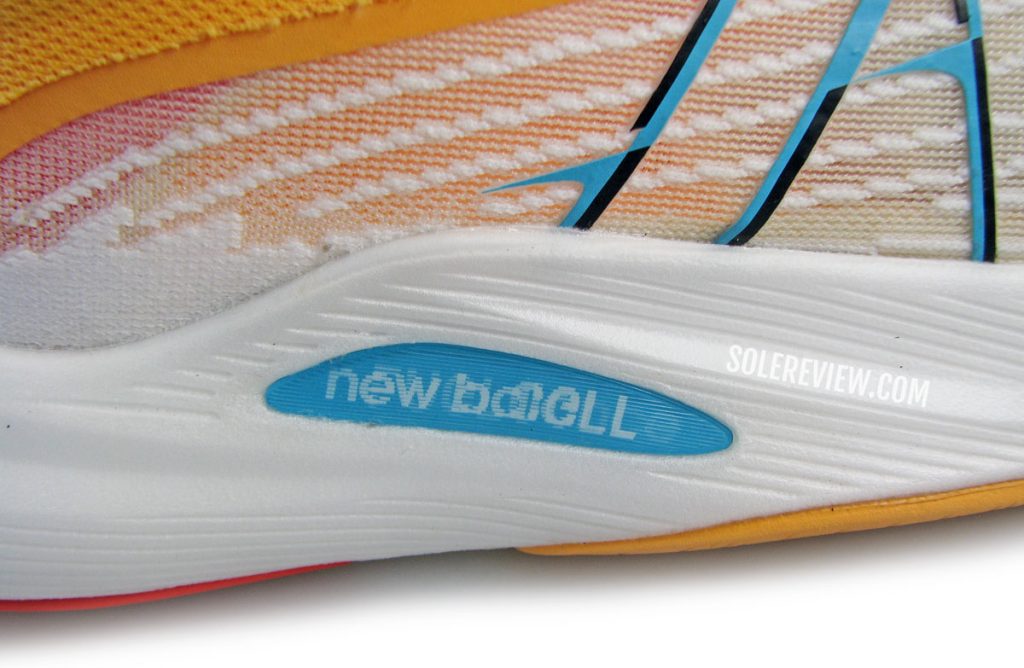
Remember those kiddo plastic rulers that changed designs depending on the angle? The shape-shifting trim on the midsole is a pleasant element of discovery.
The soft midsole is comfortable enough for everyday runs while amenable to faster paces. Though the Rebel V2 lacks a semi-plate like the V1, the inherent responsiveness of the Fuelcell midsole suits higher-paced runs.
The Rebel V2’s brand-new upper has been simplified to make it more breathable and easier to wear. Instead of a sock-like entry that the V1 had, the Rebel 2 uses a wide tongue with a soft and asymmetrical flap. The slim upper fits a half-size small, but doesn’t feel narrow as long as you’re sized correctly.
All of this is crammed into an astonishing 7.2-ounce (204 gram) weight, and the shoe delivers a fit and ride experience that’s free of all distractions. Given its level of cushioning tech, the $130 price is decent value as well.
Most runners would attest to the merits of this shoe, so the New Balance Fuelcell Rebel V2 ended up being the surprise break-out hit of 2021-22.
However, despite its outward appearance of all-around excellence, the Rebel V2 has numerous flaws.
While our reviewed pair did not face exhibit durability concerns due to the low mileage, there are numerous reports of the upper and rear midsole failing prematurely.
The midfoot lacks support as well. By this, we refer not to a narrow midfoot waist or low arch support, but an absence of a mechanism that supports the plantar fascia. More on this topic in the following section.
Here’s hoping that the next version of the Rebel is fortified to increase its levels of durability and stability.
THE RIDE EXPERIENCE
What we’re about to say next may come as a surprise. But when we try to compare the Rebel V2’s ride character with other shoes, the Rebel V1 isn’t the first shoe that comes to mind.
The lightweight Nike Pegasus Turbo was one of the first shoes to feature the ZoomX foam without a plate. It was similar to the Rebel V2 in spirit – the soft and bouncy midsole was versatile enough for daily runs and tempo days.
It’s a shame that Nike discontinued the Turbo; the shoe had so much potential.
Another product that’s worth comparing is the Puma Liberate Nitro.
The Liberate is marketed similarly to the FuelCell Rebel – it’s a lightweight tempo trainer that blends soft cushioning with a quick feel. The 6.3-ounce Liberate Nitro is lighter than the Rebel and uses a soft and springy foam that’s comparable with the Fuelcell.
All three products also share a somewhat negative aspect – the midsole lacks support in the midfoot area. And why is this a bad thing?
For a shoe that uses a soft midsole, it’s important that the foot – or more specifically, the Plantar Fascia ligament – is supported during the gait cycle.
And we’re not talking about a fancy medial post or plastic shank here – just a midsole that doesn’t apply upward pressure on the ligament.
One of the easiest ways to achieve this is to use a firm strobel fabric. When combined with a supportive insole, this creates a level surface over the soft midsole and prevents the foam from pressing against the Plantar Fascia.
In its well-intentioned attempt to enhance the cushioning feel of the Fuelcell foam, New Balance uses an extremely soft and thin lasting fabric under the removable insole. Even the insole is obligatory; it’s only a few millimeters thick.
The Rebel V2’s lasting is the thinnest and softest we’ve ever seen on any running shoe.
Both the insole and lasting achieve their objective; they allow the foot to experience the unadulterated version of the soft and springy Fuelcell foam.
It’s almost as if nothing separates the foot from the midsole – the heightened sense of cushioning is present during every stage of the gait cycle, regardless of the foot-strike or loading pattern.
As is expected, the ride is extremely comfortable, and to quote a cliched term, ‘the foot feels fresh’ even after a quick 10 miler.
However. After the first outing in the Rebel, the Plantar Fascia felt sore. Not many shoes do that. In our many years of reviewing shoes, only the adidas Pureboost, Nike Pegasus Turbo, and Skechers GoMeb Speed 3 have achieved that ignominious distinction.
Like most things running-related, the PF soreness isn’t persistent and will go away once the body adapts to the unstructured midsole.
However, if you’re recovering from Plantar Fasciitis or are generally injury-prone, we don’t recommend buying the Rebel V2.
With that out of our way, let’s look at the positive traits of the FuelCell Rebel V2.
Unlike many other tempo-worthy shoes, the Rebel 2 doesn’t have a slim midsole. It’s actually quite wide through the midfoot, with the rearfoot midsole extending past the heel line.
Though the midfoot’s wide base has shades of the Rebel V1’s ‘flange’ design, it’s not as obvious.
However, this overhang doesn’t obstruct transitions due to the generous bevel that’s skewed asymmetrically towards the outer edge.
The outsole crash pad works independently to enable smooth landings and transitions for rearfoot strikers.
Despite the softness, the rearfoot landings do not feel unsteady. The foot is on a lower level than the midsole sidewalls, so it’s ‘cupped’ by the edges. The stack isn’t overly thick, so that helps too.
Lastly, the soft lasting and FuelCell foam makes sure that the foot loads in the center. The balanced midsole design gives the Rebel 2 a distinctly neutral flavor.
Just like the first version, the Rebel V2 is an excellent running shoe for forefoot strikers. There’s plenty of deep cushioning to tap into, and the wide midsole provides a reliable foundation to land and launch from.
The heel-to-toe offset is 6 mm, New Balance’s favorite ‘drop’ for tempo trainers. It’s funny how certain offset numbers are associated with the brands. Saucony goes for 4 mm (Kinvara) and 8 mm (Ride, Guide, et.al), Hoka uses a 5 mm offset, and Altra is 0 mm, of course.
Besides its softness and responsiveness, one of the things we love about the Fuelcell foam is that it doesn’t bottom when loaded. The compression cycle is quick, and the foam snaps back to its original shape.
We tested the Rebel V2 during the cold winter mornings of Toronto, Canada – and that included many sub-zero degree (Celcius) runs.
Unlike standard EVA foam or even rubber-blend materials like the Nike React, the New Balance Fuelcell foam did not stiffen in the cold and retained its cushioned bounciness.
The outsole isn’t much to look at. The rubber slabs are thin and soft, thus allowing them to bend whenever the midsole does.
Our initial reservations about the grip quality were dispelled by the on-road performance. The flat lugs offer excellent traction, including damp roads.
So where do we see the Fuelcell Rebel V2 fit into a shoe rotation? Can this be the one shoe to do it all? It certainly has the potential, so its fragile build quality is disappointing.
If not for its potential durability concerns, the Rebel V2 would have been an excellent everyday trainer.
The soft Fuelcell foam makes even relaxed runs a comfortable affair, and there’s no pressure to go fast.
The cushy properties of the foam are easily accessible at any speed without any mushiness. The lightweight foam is lively as it gets. A 10 min/mile (6 min/km) pace feels just as doable as a spirited 7 min/mile (4:30 min/km) speed. Over longer distances, the 204 gram/7.2-ounce weight makes for easy wear. The Rebel is easily capable of going half-marathon distances and beyond.
We’ll probably recommend another rotational strategy when the updated (and hopefully more durable) Rebel 3 is released. But for now, we can think of the Fresh Foam 1080 V11 as a reliable muncher of long miles and such. Its upper is soft, and the midsole delivers a cushy ride.
We struggle with the third rotational shoe, because New Balance doesn’t have the 1400V6 listed on its site. In lieu, we recommend the Fuelcell RC Elite 2 – a shoe that uses the same Fuelcell foam as the Rebel V2, but with a completely different use case.
The RC Elite 2’s higher stack height and Carbon plate make it (more) suitable for higher-mileage efforts at speeds.
However, if you explore alternatives outside New Balance, a road racer like the Saucony Type A9 is excellent for short-distance races.
Our favorite plate-cushioned racer continues to the Saucony Endorphin Speed V2 because of the value it offers at the price.
IS THE NEW BALANCE FUELCELL REBEL V2 DURABLE?
The Nike Mayfly was designed to be the original disposable running shoe. Named after the Mayfly – an insect that lives its full life in 24 hours – the Nike shoe was supposed to last a marathon and self-destruct. Or at least, that was the idea. Nike is always good at story telling.
Except, the New Balance Fuelcell Rebel V2 wasn’t designed to be a disposable shoe. But if the internet feedback is anything to go by, then the Rebel V2 isn’t as durable as New Balance hoped it to be.
There are a couple of potential problem areas. The first is the ultra-thin upper mesh, pictured here in shimmery white.
Looking at the pictures of used shoes (read the user reviews on New Balance’s website), the upper seems to tear close to the midsole edge. We’re not saying it will happen to every pair, but this tearing does occur. Take it as a caveat emptor, if you will.
The second feedback refers to ‘the heel midsole collapsing’ or ‘the shoe developed a hole in the midsole’. From what we can tell, it is highly unlikely for the foam to actually collapse.
We strongly suspect that the ultra-thin lasting fabric is the reason behind the ‘collapse’. Its wear and tear could explain the ‘hole’ or gap that the online reviews refer to, as the fabric is no longer there to support the foot during landing.
After 50 miles, the outsole seems to be doing okay. Even though it is soft, the flexible design spreads the wear and tear evenly.
Given the unpredictable durability outcome, we think that the New Balance Fuelcell 2 will last anywhere between 100 to 500 miles, with 250 miles being the median.
THE UPPER DESIGN AND FIT
The first thing that everyone should know about the Rebel V2’s upper is that it fits small. If you usually size into a US 9, then the appropriate size for the Rebel should be US 9.5.
Once sized correctly, the upper will accommodate most runners in its standard width. There is an optional ‘wide’ size for those who need one.
This is a shoe meant for tempo runs, so the forefoot has a snug fit that prevents the foot from sliding.
The midfoot and heel are equally effective at securing the foot, and this is despite the heel lacking a stiff internal counter.
On the bright side, the absence of an internal counter means that the collar is soft on the Achilles. By the way, there’s no reflectivity on the upper. The white portion of the mesh has a shimmery texture, but is not reflective.

Here’s how the toe box looks from the inside. The tongue edges on the top are soft and non-irritating.
The lightweight mesh makes the interiors extremely well-ventilated. Even the tongue has perforations for air circulation, so this snug-fitting shoe doesn’t feel stuffy at all.
The toe-box has an internal bumper that creates a dedicated space for the toes to move freely.
The laces also begin on the midfoot rather than the forefoot. Technically speaking, the first row of lacing is over the forefoot. But the asymmetrical slant means that the first row effectively begins on the midfoot.
We noticed that even the new RC Elite 2 follows a similar lacing strategy.
This design eases on the top-down pressure without compromising fit security. The soft, elastic laces lie flush over the thinly padded tongue to distribute the cinching pressure.

What does an ultra-wide tongue flap do? It’s good at not sliding sideways. Also note the perforations and minimal foam padding on the Rebel’s tongue.
There’s no gusset inside the Rebel V2. However, the tongue doesn’t move sideways during runs because of the ultra-wide flap that’s also asymmetrical to help it lock over the instep.
As for the flap material, the raw edges are soft and completely distraction-free – as is the rest of the upper.
PROS AND CONS
If not for the looming specter of premature upper failure, the New Balance Fuelcell Rebel V2 is a delightful running shoe.
It’s lightweight, soft, responsive, grips well, and priced reasonably for its level of tech. Hey, there’s even an optional width and a size US 16 available.
Based on internet chatter, New Balance is going to completely overhaul the Rebel for its third outing. For a change, we’re actually looking forward to a shoe receiving its annual update.
SHOES SIMILAR TO THE NEW BALANCE FUELCELL REBEL V2
The Puma Liberate Nitro is the Rebel’s closest match – both from a sensory and performance viewpoint. The Puma Liberate Nitro undercuts the Rebel’s price by $20, thus making it exceptional value.
The Liberate Nitro is also lighter and delivers similar performance benefits, thanks to the soft and responsive Nitro foam. The lightweight upper has a deconstructed, racer-like fit for high-speed training.
Among other alternatives are the Brooks Hyperion Tempo and Skechers Razor Excess. Both shoes are lightweight tempo trainers that are also versatile enough for everyday training.
Do you own this shoe? Improve this review by sharing your insights – submit a review here.



